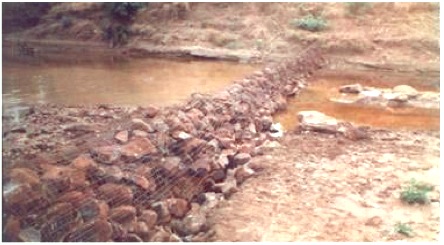Water Portal / Rainwater Harvesting / Groundwater recharge / Gabions
A gabion is semi permeable barrier, made of boulders in a mesh of steel wires and anchored to the stream bank, to slow but not stop, the flow of storm water in a small watercourse so to favour water infiltration to groundwater and help prevent soil erosion.
The height of such structures is around 0.5 m and 1m wide, and is normally used in the streams with width of less than 10 m.
Since gabions are bound together, the wire mesh is extremely strong under tension, where concrete is not. A gabion structure will withstand a degree of tension that would severely test a dry stone construction and be downright dangerous with plain concrete and masonry. The wire mesh shell is not simply a container for the stone filling, but a reinforcement of the entire structure. And a well-made gabion can withstand years of punishment: one used in Italy for protection of river banks, more than 100 years ago, was recently examined and found to be still in perfect condition.
Contents
Suitable conditions
- Gabions should be located within a straight reach of the watercourse, not on a curve nor immediately after a curve.
- A poorly constructed gabion can do more harm than good by diverting water towards the bank. Consult a qualified professional.
Construction, operations and maintenance
A gabion structure can be built without any mechanical equipment and works can start immediately because the initial stages of excavation and laying of foundations are minimal and can be carried out by hand. Likewise, for underwater structures, the first layer of gabions can be laid in water or in mud without the need for draining the site. Upon completion, a gabion structure will take its full load immediately without the waiting periods - of up to one month - normally associated with concrete structures. Furthermore, it is relatively easy to obtain good construction quality because of the simplicity of the two construction materials, i.e. the gabion baskets and the stones or rock fragments.
Maintenance
Inspect gabions following major runoff events. Adjust apron size, gabion width, and gabion height as needed based on its performance.
Costs
A gabion structure costs much less than a conventional structure. Low grade or even waste stones, usually found close to the work site, can be used to fill the wire cages, with no specialized materials or labour - such as formworkers, masons or ironworkers - being required. Labour costs are minimal as unskilled labour, under the supervision of a few skilled workers, can be trained quickly to erect the gabion baskets, fill them and tie them together with galvanized iron wire. All of which makes this simple technique easy to introduce to rural people, who can also be actively involved in both the construction and future maintenance of hydraulic structures.
Field experiences
AGLW has long experience with gabion construction in various countries of the developing world, including Botswana, Ethiopia, Niger, Nigeria, China, Viet Nam and Haiti, where water development and irrigation projects have all made use of either imported or locally-made gabion baskets. The structures most frequently consist of an earthfill embankments and gabion-based anti-erosion protection and a surface spillway made from gabions.
Reference manuals, videos, and links
Acknowledgements
- Gabions in water development. FAO, 1998.
- Rufino, L., Water Conservation Technical Briefs: TB 2 – Rainwater Harvesting and Artificial Recharge to Groundwater. Sustainable Agriculture Initiative (SAI). August 2009.

